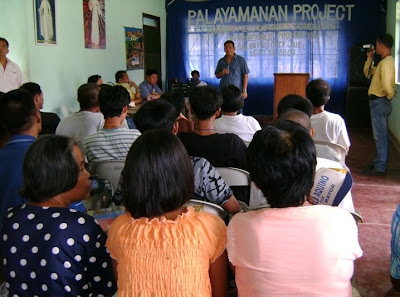Mayor Mel Senen Sarmiento was in New York September 22 – 25, 2008 as the Philippine Representative during the Side Event on Local Poverty Reduction and MDG Localization. The said activity was part of the United Nations High-Level Event on the Millennium Development Goals (MDGs).
Sarmiento, who is also the Secretary-General of the League of Cities of the Philippines (LCP) and the Chair of the Regional Development Council (RDC-8) participated in the first Round-Table Session which discussed “The Localization in tandem with national scaling up efforts: Bridging the gap between local and national levels”.
In that session, the Philippines, Brazil and Uganda made their presentations on MDG localization and national scaling up efforts. The presenters tried to answer some critical questions like the major challenges for policy alignment for MDG planning and implementation at national and local levels; and how those challenges have been overcome? They also discussed the effective ways to sensitize local government and parliamentarians on MDG and the key elements of success in bridging the gap between national and local levels in scaling up MDG implementations.
Mayor Sarmiento’s presentation entitled “Local Poverty Reduction and MDG Localization: Scaling Up the Achievement of MDGs” focused on the partnership between local and national level governments for MDGs. Most notable in that report are the following points:
On the Environment for Localization:
At the local level, Goals 1-5 and Goal 7 are devolved functions to local government units (e.g. health, safety, social justice, employment, environment, etc.). Philippine law has mandated the LGUs as primarily responsible for providing basic social services (RA 7160). LGUs are also responsible for the formulation, implementation, monitoring and evaluation of the Anti-Poverty Action Agenda in their respective jurisdictions (RA 8425).
At the national level, the 10-Point Agenda of President Gloria Macapagal Arroyo mirrors the MDGs. And The Philippines remain strongly committed to the Millennium Declaration. This commitment is not mere lip service because in fact MDG targets are mainstreamed in the Medium-Term Philippine Development Plan (2004-2010). However, National Government Agencies have limited capacity to support LGUs who remain as the frontliners in the delivery of basic services to the people.
Taking a cue from his personal experience in Calbayog and that of the 13 other pilot LGUs, he enumerated the characteristics of an MDG-Responsive LGU:
- First, local plans include specific MDG-related targets and budget. The plan should show increased or increasing allocation for MDG-related services.
- Second, improvements in the delivery of social services are adopted. Those that have been identified as best practices, at the international, national or local level, are replicated.
- Third, monitoring systems are in place to track down effective and efficient utilization of resources. The monitoring system should also welcome feedback from the community.
- Fourth, institutional reforms are pursued. This could involve governance reforms at the barangay (village) level.
- And finally, local leadership makes the MDGs a performance commitment. And the local chief executive reports on this performance to his constituencies.
In answering the issue on bridging the gap between the national and local levels, Mayor Sarmiento enumerated the basic MDG localization process followed in the Philippines:
- Advocacy campaigns
- Institutionalization of the MDG Localization process
- Baselines – Minimum Basic Needs Survey, Community Based Poverty Information System –
- Local Poverty Indicators and Monitoring System
- Setting Local Targets, Indicators, Programs, Projects and Activities
- Mainstreaming local MDG targets in short and long term plans
- Measuring Results, Evaluation and Tracking Outcomes
Mayor Sarmiento also informed the event participants that in the Philippines, MDG localization means bringing the MDGs down to the individual child. For MDGs to make a real difference in people’s lives, they cannot remain to be the concern of the national government or the LGUs alone. The MDGs have to be understood and owned by the individual families. The meaning of the MDGs has to be translated to its significance in the daily life of an individual child.
The report concluded with the Mayor enumerating the key elements for success. He cited the three most critical elements based on the Philippine experience:
First, it is strategic to institutionalize the engagement and ownership by all levels of stakeholders (city, village, neighborhood and family) in program development, implementation and monitoring – in all the process of development.
Second, it is fundamental to make the MDGs meaningful to the families especially the vulnerable sector. Instead of considering them as “beneficiaries” as is the traditional thinking, they should be harnessed as “development partners”. Their capacities should therefore be developed as such partners.
Third, information is a key in poverty profiling and establishing development baselines using accurate household level data. City-wide mainstreaming of MDG targets in the LGU’s Medium-Term Development Plans, Executive and Legislative Agenda and Annual Investment Plans should be facts-based and knowledge-driven.
The event happened around the same time when heads of states started to arrive in New York for the opening of the UN General Assembly. It resulted in the last-minute change of venue for the event. As per request by the Secret Service, the presentations and discussions were moved to the Grand Hyatt Hotel in Manhattan.
Other countries invited to the event included Rwanda, Vietnam, India, Kenya and Liberia. Key messages in presentations will be used to inform the MDG localization agenda and will be transmitted to the Office of the UN Secretary-General. The agencies that coordinated the event included the United Nations Development Programme (UNDP), United Nations Human Settlements Programme (UN-HABITAT) and United Nations Capital Development Fund (UNCDF), among others.
 Mayor Mel Sarmiento with City Schools Division Superintendent Edita Paculan (rightmost), ASDS Angelo Gelera (to the mayor's left) and other DepEd officials as they await the President's arrival.
Mayor Mel Sarmiento with City Schools Division Superintendent Edita Paculan (rightmost), ASDS Angelo Gelera (to the mayor's left) and other DepEd officials as they await the President's arrival.




























